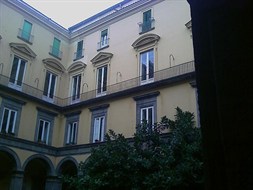The cardinal in Naples: Palazzo Filomarino
On December 16, 1641 Urban VIII appointed Ascanio Filomarino Archbishop of Naples, in place of Cardinal Francesco Boncompagni, and elected him at the same time the Cardinal of Santa Maria in Aracoeli. Filomarino would stay in the capital of the Spanish viceroyalty until his death, for more than twenty years (1641-1666), clearly leaving its mark in a very delicate phase of Neapolitan history. A leading figure in the political scene, as well as religious and social life of the city, Filomarino was publicly at odds with the public and the lay authorities of Naples, by defending privileges, prerogatives and rights of the Church and the clergy, but also on account of authentically political reasons. He had a stormy relationship with the viceroys sent from Madrid, particularly with the Duke of Medina de las Torres (viceroy from 1637 to 1644) and the Count of Oñate (1648-1653). The latter especially harshly accused Filomarino of plotting against Spanish power and being in favour of French interference, asking several times, and in vain, for Filomarino’s removal as Archbishop of Naples. The protection of Pope Innocent X, however, allowed Ascanio to continue his tenure at the foot of Mount Vesuvius.
 During his years in Naples, Filomarino continued his activities as a collector and patron of the arts, making of the Filomarino Palace (photo: courtyard) the home of an important art collection. The Palace, located in the present-day Via Benedetto Croce in the city centre, stands on the site where the house of a certain Giovannello Brancaccio was built in the fifteenth century. The structure was redesigned and enlarged by the architect Giovanni Francesco Palma, when the powerful family of the Sanseverino from Bisignano acquired the building, probably in the second half of the fifteenth century. The ownership of the building passed to the Filomarino in the early seventeenth century. The portal, from the Baroque period, was the work of the architect Ferdinando SanfeliceFerdinando Sanfelice (1675-1748) was born and died in Naples, where he worked intensely both as an architect and creator of ephemeral installations for secular and religious celebrations, in typical Baroque style. Of aristocratic birth, he also worked in other centers such as Salerno and Nardò., while the balconies of the second floor are in an unmistakable Neo-Classical style. Restructured following the damage caused by the bombing of the city during the so-called Masaniello revolt, the Palace has undergone several changes and additions in later centuries, as evinced by the current overlap of various artistic styles. In the twentieth century the philosopher Benedetto Croce bought the second floor of the palace, where he founded the Istituto Italiano per gli Studi Storici (Italian Institute for Historical Studies) and where he died, November 20, 1952.
During his years in Naples, Filomarino continued his activities as a collector and patron of the arts, making of the Filomarino Palace (photo: courtyard) the home of an important art collection. The Palace, located in the present-day Via Benedetto Croce in the city centre, stands on the site where the house of a certain Giovannello Brancaccio was built in the fifteenth century. The structure was redesigned and enlarged by the architect Giovanni Francesco Palma, when the powerful family of the Sanseverino from Bisignano acquired the building, probably in the second half of the fifteenth century. The ownership of the building passed to the Filomarino in the early seventeenth century. The portal, from the Baroque period, was the work of the architect Ferdinando SanfeliceFerdinando Sanfelice (1675-1748) was born and died in Naples, where he worked intensely both as an architect and creator of ephemeral installations for secular and religious celebrations, in typical Baroque style. Of aristocratic birth, he also worked in other centers such as Salerno and Nardò., while the balconies of the second floor are in an unmistakable Neo-Classical style. Restructured following the damage caused by the bombing of the city during the so-called Masaniello revolt, the Palace has undergone several changes and additions in later centuries, as evinced by the current overlap of various artistic styles. In the twentieth century the philosopher Benedetto Croce bought the second floor of the palace, where he founded the Istituto Italiano per gli Studi Storici (Italian Institute for Historical Studies) and where he died, November 20, 1952.
